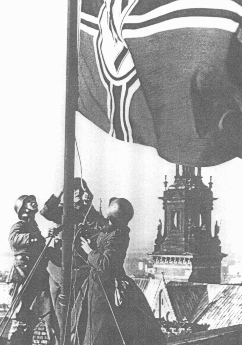 Holocaust Encyclopedia – Krakow (Cracow)
Holocaust Encyclopedia – Krakow (Cracow)
Copyright © United States Holocaust Memorial Museum, Washington, DC

The Nazi flag is raised over the Krakow castle. Krakow, Poland, 1939. (Library of Congress; Unknown or unpublished)
JEWISH POPULATION OF KRAKOW
Founded before the end of the first millennium, the city of Krakow (Cracow), located today in southern Poland, served as the seat of the Piast Dynasty and eventually as the capital of the Polish Kingdom until the early 17th century. After the third partition of Poland in 1795, Krakow became the seat of Galicia province in the Austrian Empire. In 1918, with the reestablishment of the Polish state, Krakow became and remains one of its most important cities.
The first recorded presence of Jews residing in Krakow dates from the early 13th century. 55,515 Krakow residents identified themselves as Jews in the Polish census of 1931; on the eve of the war some 56,000 Jews resided in Krakow, almost one-quarter of a total population of about 250,000.
By November 1939, the Jewish population of Krakow had grown to approximately 70,000. This increase reflected the concentration of Jews who fled or were driven from the countryside into the city and its suburbs, and the arrival of Jews deported east from the District Wartheland (a part of German-occupied Poland that was directly annexed to the so-called Greater German Reich).
GERMAN OCCUPATION OF KRAKOW
Upon the German invasion of Poland, the German army occupied Krakow in the first week of September 1939. The German military authorities initiated immediate measures aimed at isolating, exploiting and persecuting the Jews of the city. On October 26, 1939, that part of German-occupied Poland which the Germans did not annex directly came under rule of civilian occupation authorities under the leadership of Hans Frank, the former legal counsel to the Nazi Party. Appointed Governor General by Adolf Hitler, Frank established his headquarters in the Wawel Castle in Krakow, which the Germans designated as the capital of the Generalgouvernement. On Frank’s staff was SS General Friedrich-Wilhelm Krüger who as Higher SS and Police Leader commanded all SS and police personnel stationed in the Generalgouvernement.
Krakow was also the capital of Krakow District in the Government General. The first District Governor was SS Major General Otto Wächter. When Wächter took over Galicia District in 1942, SS Major General Richard Wendler, SS chief Heinrich Himmler’s brother-in-law, was the District Governor until his reassignment to District Lublin in July 1943. The SS and Police Leaders for District Krakow were: SS Lieutenant General Karl Zech until 1940, SS Colonel Julian Scherner from 1941 until February 1944, and SS General Theobald Thier from February 1944 until the German evacuation in January 1945. The Commander of Security Police and SD for District Krakow was SS-Lieutenant Colonel Max Grosskopf. The German Security Police established their headquarters near the Montelupich Prison.
Like elsewhere in the Generalgouvernement, the German occupation authorities required Jews in Krakow city and the surrounding areas to report for forced labor (October 1939), form a Jewish Council (November 1939) identify themselves by means of a white armband with a blue Star of David to be worn on the outer clothing (December 1939), register their property (January 1940-March 1940), and to be concentrated in ghettos (September 1940-March 1941).
KRAKOW GHETTO
In May 1940, the Germans began to expel Jews from Krakow to the neighboring countryside. By March 1941, the SS and police had expelled more than 55,000 Jews, including refugees from the German-annexed District Wartheland; about 15,000 Jews remained in Krakow.
Read more: Holocaust Encyclopedia…
twoje uwagi, linki, wlasne artykuly, lub wiadomosci przeslij do: webmaster@reunion68.com
